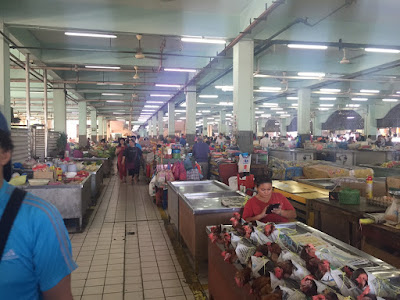We’re about half-way through week seven (yikes!) and the
pressure is about to set in for the Sibu Six.
There’s been talk of wrapping up sample collection soon, and it’s crazy
to think things are moving this fast! So,
what have we been doing these past 6+ weeks you ask? Jane, Hudson, and Sarah have been working
with medical officers in the hospital to enroll patients. Kerry and Rick have become regulars at the
local markets on their daily strolls with the bioaersol samplers. And of course, we’ve all been putting in lots
of lab time doing DNA/RNA extractions and RT-PCR. On top of all of that, we’ve been hitting the
field, and by that I mean the pig farm!
 |
| Sarah and I collecting samples from the pigs. Photo credit: Jim Rogalski |
Two of our three major studies are using samples collected from pigs. The study Kerry, Rick, and I are working on involves collecting oral secretions and fecal samples from the pigs, bioaersol samples, and nasal wash samples from the workers (explanations to come, don’t worry!). Our main objective is to see if viruses infecting the pigs are being aerosolized and hanging out in the noses of the workers. Sarah is also using the pig fecal samples to see if the same diarrheal virus she’s looking for in humans (norovirus) is infecting pigs as well. Isn’t research glamorous!
To describe a typical farm visit would be nearly impossible (though I’m going to try) as every farm has many quirks and kinks of their own. We’ve seen your standard farms with pens of big pink sows munching on corn meal, and we’ve also seen your glorified mud pits with “local pigs,” or as they’re known in Malaysia, babi kampung.
 |
| Mix of babi kampung and traditional domestic pigs enjoying what can only be described as pig heaven. |
Our first farm visit was a mild train wreck. We were overly prepared in some respects, but
essentially unaware of what to expect in others. After nine visits (and counting), we’ve got somewhat
of a routine down. After we’ve confirmed
consent with the farm owner, Sarah and I head off to collect the pig samples
while our local collaborators start enrolling workers, and Kerry and Rick find
the perfect spot to setup the bioaerosol sampler.
The oral secretion collection is dependent on
pigs chewing on a piece of cotton rope, and while some pigs LOVE the new toy,
others just won’t bite (mainly the babi kampung, we’ve noticed.) The fecal specimens are collected by “convenience
sampling,” but it’s not always convenient for us to reach and sometimes the
pigs get a bit too nosey when we’re swabbing. After we’ve collected five of each sample
type, we rejoin the rest of the group and help with human nasal washes.
 |
| Piggo enjoying rope. 10/10 would recommend |
To answer what I’m sure is just one of many questions at this point, a nasal wash is a simple application of water into one nostril that the participant then expresses into a sample collection cup. A wash, in this scenario, provides a more comprehensive sample than a simple swab by getting into more of the nose’s nooks and crannies- again, glamourous stuff. Once we’re done, we bleach down and head back to the lab to process samples. The viruses we’re looking for are currently only known to infect pigs, but we’re looking to see if humans are at any risk of inhaling aerosolized virus. This study alone won’t prove infection, but it’s a pilot for future, more comprehensive studies.
Needless to say, it’s been a spectacular, albeit smelly
summer. We’re still loving Sarawak and
all the adventures (and food) it has to offer.
Now, it’s time to hit the lab, and soak up what we can from our last three and a half weeks in Sarawak (the Borneo Cultural Festival begins in a few days and we’re very excited!). The Sibu Six are sure to make some exciting findings, so stay tuned for crunch-time updates!
Now, it’s time to hit the lab, and soak up what we can from our last three and a half weeks in Sarawak (the Borneo Cultural Festival begins in a few days and we’re very excited!). The Sibu Six are sure to make some exciting findings, so stay tuned for crunch-time updates!













